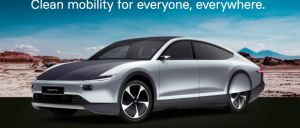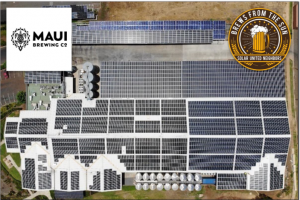July 12, 2019 – Volume 21, Issue 6
In This Issue
- Flanigan’s EcoLogic: The American Offshore Wind Race
- Oil Rigs to Reefs!
- General Electric Gas Plant Closure
- Lightyear One’s 450 Miles of Range
- Solar Booming in Florida!
- Dubai’s 900 MW Solar Tender
- Solar Brew Pubs Celebrated
- New York City Declares Climate Emergency
- The TWA Hotel at JFK
- Japan’s Virtual Power Plant
- EcoMotion Update: Residential Solar Workshop in Carson

Flanigan’s EcoLogic: The American Offshore Wind Race
RenewableUK reports that the global offshore wind market grew by 16% over the last 12 months. It’s all about bigger and better technology. Wind turbines being employed on new projects generate three times the power of turbines just five years ago.
Globally, offshore wind in operation, under construction, or in development rose from 105,000 MW to 121,000 MW. China has 12,000 MW in the pipeline; Taiwan 8,900 MW. In the North Sea off the United Kingdom, the world’s biggest offshore wind farm just came on line. Located 75 miles offshore, its turbines anchored to the sea floor, Hornsea One has a generating capacity of 1,200 MW, pushing the U.K.’s offshore wind generating capacity to 8,200 MW, the largest in Europe.
While the United States has only 30 MW of offshore wind installed, the United States now accounts for nearly half of the rapid global growth reported by RenewableUK. The U.S. has wind farms planned in Massachusetts (with a goal of 1,600 MW), Rhode Island, Connecticut, New York, and Maryland. There’s a race being run between these states given wind potential to develop 20,000 MW of offshore wind on the East Coast by 2030, representing a $70 billion business opportunity according to research at the University of Delaware.
In April, Massachusetts approved its first offshore contracts for 800 MW; New York is concurrently working to procure 800 MW or more. On July 1st the Connecticut Department of Energy and Environmental Protection (DEEP) issued a draft Request for Proposals to procure up to 2,000 MW of offshore wind capacity to begin delivery no later than 2026.
The largest offshore wind procurement in the U.S. just took place in New Jersey. The Garden State selected Denmark’s Orsted A/S to develop a 1,100 MW wind project off the coast of Atlantic City. The New Jersey Board of Public Utilities (BPU) reviewed a number of proposals including one presented by Equinor from Norway and a joint venture between EDF Renewables North America and Shell New Energies. The BPU cited experience as a determining factor; Orsted bought offshore wind developer Deepwater Wind last year.
“New Jersey is going to be finally open for business as far as offshore wind is concerned,” said BPU President Joseph Fiordaliso. This project is the first step in the State’s commitment to contract for 3,500 MW of offshore wind by 2030. The project is called Ocean Wind, will create 15,000 jobs, and is expected to be completed in 2024.
Quote of the Week
“Just as solar panels are increasingly dotting our land, then, it seems gigantic wind turbines are set to dot our seas.”
Vanessa Bates Ramirez, Singularity Hub
Oil Rigs to Reefs!
 Could California’s offshore oil rigs find new life as underwater reefs? Two University of California Santa Barbara professors are finding that reefing the habitat under decommissioned oil and gas platforms could well be beneficial for California and its coastal biodiversity.
Could California’s offshore oil rigs find new life as underwater reefs? Two University of California Santa Barbara professors are finding that reefing the habitat under decommissioned oil and gas platforms could well be beneficial for California and its coastal biodiversity.
Since 1969 when an offshore oil rig ruptured and spilled 80,000 – 100,00 barrels of crude oil into the ocean off Santa Barbara, offshore oil and gas drilling has been contentious in California. Now the debate has shifted to whether or not to completely dismantle 27 oil and gas platforms along the southern coast of California as they end their useful lives, or to convert their underwater sections into permanent artificial reefs for marine life.
The typical useful life of an offshore oil rig is 25 – 50 years. Federal and state laws require energy companies to decommission them, completely removing the platform and submerged supporting structure and returning the sea floor to its unobstructed condition. They were never designed to be reefs, but their underwater steel pipe support systems – called “jackets” – attract vast numbers of invertebrates that settle, in turn attracting fish. Millions of mussels, sea stars, and brightly colored anemones fight for space, creating a quilt of patterns and textures.
Working with state fisheries agencies, energy companies have converted decommissioned oil and gas platforms into man-made reefs in the U.S. Gulf of Mexico, Brunei, and Malaysia. The work off Santa Barbara could serve as a model for the decommissioning some of the 7,500 other offshore platforms operating around the world.
General Electric Gas Plant Closure
 General Electric announced in June that it will demolish its 750 MW Inland Empire Energy Center in Sun City, California this year after only one-third of its useful life. GE stated that the plant is no longer economically viable where wind and solar supply a growing share of the State’s inexpensive electricity. The closure illustrates stiff competition in the deregulated energy market. Cheap renewables are squeezing out fossil fuels.
General Electric announced in June that it will demolish its 750 MW Inland Empire Energy Center in Sun City, California this year after only one-third of its useful life. GE stated that the plant is no longer economically viable where wind and solar supply a growing share of the State’s inexpensive electricity. The closure illustrates stiff competition in the deregulated energy market. Cheap renewables are squeezing out fossil fuels.
The plant suffered from technical problems. It is made up of two GE H-class turbines that have now been succeeded by GE’s air cooled, HA model. GE’s H-class technology is reportedly complex, takes hours to start, and suffered technical problems and sold poorly. The plant will be shut by the end of 2019.
Fundamentally, “the plant is not designed for the needs of the evolving California market with requires fast start capabilities to satisfy peak demand periods.” It’s an orphaned technology. The HA can power up in a single hour. The $1 billion plant in Riverside County – 75 mile west of LA – opened in 2009. Normally such plants operate for 30+ years. GE is selling the plant to a company that makes battery storage.
Lightyear One’s 450 Miles of Range
 Lightyear has unveiled the first prototype of the Lightyear One, an EV covered in solar panels that it plans to start selling in 2021. Pundits say that it has an “eye-watering price,” a cool $135,000 to reserve one and $170,000 to buy one. Lightyear was founded in 2016 by Solar Team Eindhoven from the Netherlands, a team of engineering students who won the solar power World Solar Challenge race in 2013, 2015, and 2017. Their cars, named “Stella” were loaded with solar that produced more power than they consumed, meaning that you could end a journey with more charge than when you started!
Lightyear has unveiled the first prototype of the Lightyear One, an EV covered in solar panels that it plans to start selling in 2021. Pundits say that it has an “eye-watering price,” a cool $135,000 to reserve one and $170,000 to buy one. Lightyear was founded in 2016 by Solar Team Eindhoven from the Netherlands, a team of engineering students who won the solar power World Solar Challenge race in 2013, 2015, and 2017. Their cars, named “Stella” were loaded with solar that produced more power than they consumed, meaning that you could end a journey with more charge than when you started!
Lightyear claims that the car will have a range of 450 miles. The car has five square meters of solar panels, covering its roof and hood and can charge the battery pack by 7 miles of range an hour… outpacing the market-leading Tesla’s 370 miles of range. It can also support 60 kW of fast charging, giving its four electric motors 315 miles of range per hour of charge. The company is taking orders for its first 500 vehicles.
Solar Booming in Florida!
 For many years Florida’s solar policies have lagged behind other states: Sadly, the Sunshine State has no renewable portfolio standard and does not allow power purchase agreements, two policies that have driven investments in solar in other states. Now thanks to recent developments and low PV prices, significant growth is on the horizon, and Florida ranks second for projected capacity installed over the next five years, with nearly 5.5 GW expected to come on line. NREL researchers foresee Florida’s solar power penetrations climbing as high as 30% over the next ten years, up from a tenth of a percent in 2015. Duke power is planning a 700 MW solar farm in Florida; Florida Power and Light plans to build 4,000 MW of solar over the next decade.
For many years Florida’s solar policies have lagged behind other states: Sadly, the Sunshine State has no renewable portfolio standard and does not allow power purchase agreements, two policies that have driven investments in solar in other states. Now thanks to recent developments and low PV prices, significant growth is on the horizon, and Florida ranks second for projected capacity installed over the next five years, with nearly 5.5 GW expected to come on line. NREL researchers foresee Florida’s solar power penetrations climbing as high as 30% over the next ten years, up from a tenth of a percent in 2015. Duke power is planning a 700 MW solar farm in Florida; Florida Power and Light plans to build 4,000 MW of solar over the next decade.
As of the end of Q1 2019, Florida got 1.18% of its power from the sun with 3,155.51 MW of solar installed. But this will more than double with a growth projection of 8,586 MW over next five years. While the vast majority of this will be utility-scale solar, last year the Florida Public Service Commission bypassed political turmoil surrounding pending pro-solar legislation, and made solar leasing – promoted vigorously by SunRun as “solar as a service” — available to distributed solar customers who choose not to invest in upfront capital to own their own arrays. Florida “is the headline state for solar in the Southeast this year.”
The year 2018 was a banner year for solar in Florida. Solar grew by 76% in 2018. While 88% was utility-scale solar, the state deployed 113 MW of customer-owned, net energy metered solar across 13,705 installations, 68% more installations and 76% more watts than the prior year. Florida now has 317 MW of customer-owned solar, growing with lots of headroom!
Dubai’s 900 MW Solar Tender
 The next and fifth phase of the Mohammed bin Rashid Al Maktoum Solar Park located 30 miles south of Dubai in the United Arab Emirates has attracted huge interest. Fully 64 companies will submit their final bids for a total of 900 MW by August 22 of this year. The winning companies will take 40% interests in their projects, the balance will be owned by the Dubai Electricity and Water Authority (DEWA).
The next and fifth phase of the Mohammed bin Rashid Al Maktoum Solar Park located 30 miles south of Dubai in the United Arab Emirates has attracted huge interest. Fully 64 companies will submit their final bids for a total of 900 MW by August 22 of this year. The winning companies will take 40% interests in their projects, the balance will be owned by the Dubai Electricity and Water Authority (DEWA).
The solar park has been successful thanks to good access to capital and the availability of land. The park is planned to contain a whopping 5 GW of solar by 2030. The first, 13 MW phase of its development was won by First Solar and came on line in 2013. The second phase was 200 MW and was brought on line in 2017. The park has allocations for parabolic trough and solar tower technology. The third phase involved 800 MW of solar PV that was auctioned at 2.99 cents/kWh; a fourth phase 250 MW PV project was auctioned off at 2.4 cents/kWh. By 2020, the commissioned capacity will exceed 1 GW.
In related news, the International Renewable Energy Agency (IRENA) has inaugurated a 10 MW of solar facility in Cuba thanks to funding from the Abu Dhabi Fund for Development. More than 120 MW of new renewable energy capacity worldwide is set to come online in the first four cycles of the lending facility including the Cuban project and another 10 MW project planned in Mauritius. The Cuban project was developed under the second cycle of the ADFD/IRENA project facility, by which the emerati development fund will provide $350 million in lending in $50 million annual blocks.
Solar Brew Pubs Celebrated
 Solar United Neighbors, a 501c3 based in Washington DC, now hosts an annual competition to crown America’s favorite craft breweries that have gone solar. The concept behind the competition is to bring together craft beer lovers and solar energy supporters. So far, Solar United Neighbors is recognizing 137 that breweries have gone solar, from Alaska to Missouri, Vermont to Hawaii! This year’s winners were elected by 12,334 people weighing in on 44 breweries that competed across three categories.
Solar United Neighbors, a 501c3 based in Washington DC, now hosts an annual competition to crown America’s favorite craft breweries that have gone solar. The concept behind the competition is to bring together craft beer lovers and solar energy supporters. So far, Solar United Neighbors is recognizing 137 that breweries have gone solar, from Alaska to Missouri, Vermont to Hawaii! This year’s winners were elected by 12,334 people weighing in on 44 breweries that competed across three categories.
The Maui Brewing company located in Kihei on Maui is the largest craft brewer in State of Hawaii. It took first place in the “Brews from the Sun” 2019 Regional Breweries competition. Garrett Marrero and his wife started the business in 2005. High electricity prices and a desire to be sustainable has resulted in the company being close to grid independent. It is one of the lowest footprint breweries in the world.
And there’s more to come. The brewer plans to expand its 1.2 MW solar system installed in 2017 that provides 80% of its current power needs. It also has solar thermal hot water and the brewer is building an array of solar concentrators over its parking lot to super heat water. The brewer has also tapped process efficiencies including carbon dioxide recovery and re-use. Its Tesla Power Packs are being used to store electricity and to thus replace the use of gas in the brewing process.
This year’s other first place winners were the Canal Park Brewing company in Duluth, Minnesota and the Made Mole Brewing in Wilmington, North Carolina.
New York City Declares Climate Emergency
 Power in numbers: More than 670 governments in 15 countries have formally declared “Climate Emergencies” according to the Cool Earth Forum. Eighteen of these are American, but now New York City, America’s largest city with 8.62 million inhabitants, is the largest city on Earth to declare such an emergency. These governments are calling for immediate response to global climate crises. New York’s declaration cites extreme temperatures that will be, “too hot to be a safe environment.” The City and its residents, “bear an extraordinary responsibility to address these existential threats.” New York joins Dublin, Geneva, and Sydney.
Power in numbers: More than 670 governments in 15 countries have formally declared “Climate Emergencies” according to the Cool Earth Forum. Eighteen of these are American, but now New York City, America’s largest city with 8.62 million inhabitants, is the largest city on Earth to declare such an emergency. These governments are calling for immediate response to global climate crises. New York’s declaration cites extreme temperatures that will be, “too hot to be a safe environment.” The City and its residents, “bear an extraordinary responsibility to address these existential threats.” New York joins Dublin, Geneva, and Sydney.
The declarations passed by nearly 700 cities are powerful representations of municipalities’ commitments to fighting climate change with future legislation. In May, the United Kingdom became the first national government to declare a Climate Emergency. Higher learning institutions are joining the bandwagon with declarations of climate urgency. Second Nature which manages the American Colleges and Universities Presidents Climate Commitment (which has over 700 universities pledging carbon neutrality) finds that momentum is building on campuses. Last year, American University because the first university in the country to reach its goal of becoming carbon neutral. In 2019, Colgate University became carbon neutral. University of California has a carbon neutrality goal for its campuses by 2025. It’s a global movement: Strathmore University in Kenya has its own solar farm and runs on clean power.
The TWA Hotel at JFK
 For many of us who grew up in New York and for whom JFK has been our base airport (after “Idlewild” that is), the Trans World Airways (TWA) terminal is a lasting impression. The “flight center’s” bold architecture set it far apart from all other terminals. The original building was designed in 1962 by the Finnish America architect Eero Saarinen. In 1991 TWA was sold to American Airlines parent company. At that time there were proposals to repurpose the site of the TWA terminal. Then in 1994, it was deemed a landmark by the New York City Landmarks Preservation Commission. That prevented its demolition.
For many of us who grew up in New York and for whom JFK has been our base airport (after “Idlewild” that is), the Trans World Airways (TWA) terminal is a lasting impression. The “flight center’s” bold architecture set it far apart from all other terminals. The original building was designed in 1962 by the Finnish America architect Eero Saarinen. In 1991 TWA was sold to American Airlines parent company. At that time there were proposals to repurpose the site of the TWA terminal. Then in 1994, it was deemed a landmark by the New York City Landmarks Preservation Commission. That prevented its demolition.
Today the TWA terminal has new life. The building has undergone a major renovation and now is a hotel with conference facilities, the original terminal building serving as the hotel’s reception. The reformed facility opened May 15, 2019. Two new, six-story hotel buildings provide 512 rooms with runway views. The site also features a retired TWA jet. A Lockheed Constellation L-1649 Starliner was shipped to the hotel site and converted into a cocktail bar…. a lounge named “Connie.” Apparently it’s an aviation nerd’s paradise!
The hotel features ultramodern energy technologies. It operates off the grid… independent of Consolidated Edition. It has a microgrid made up of onsite generation and storage that feeds the needs of convention center and hotel. Most microgrids are grid connected and only disconnect when the grid fails. But this one is independent… it operates all the time using a 1 MW, rooftop power plant that supplies all its heating, cooling, and electrical needs. Three NEC natural gas-fired generators and a NEC-made battery comprise the system.
Japan’s Virtual Power Plant
 Japan’s virtual power plant – the AutoGrid-ENERES VPP — fulfills the function of a traditional central power station, but its operations are highly distributed. And in this case, the distributed power plant’s assets are “behind the meter,” meaning its distributed elements are on customers’ premises. According to the California company developing the project, Autogrid, the project is being described as the world’s largest behind-the-meter, microgrid virtual power plant (VPP). Schneider Electric recently bought a stake in Autogrid.
Japan’s virtual power plant – the AutoGrid-ENERES VPP — fulfills the function of a traditional central power station, but its operations are highly distributed. And in this case, the distributed power plant’s assets are “behind the meter,” meaning its distributed elements are on customers’ premises. According to the California company developing the project, Autogrid, the project is being described as the world’s largest behind-the-meter, microgrid virtual power plant (VPP). Schneider Electric recently bought a stake in Autogrid.
The AutoGrid-ENERES VPP project’s genesis was the Fukushima nuclear plant disaster in 2011. The region is still short on capacity from the loss of the plant in 2011. In addition, Japan has been deregulating its power market since 2016, a change that has attracted innovation and competitive players. The virtual power plant will initially use only batteries; 200 are slated for deployment this year. Later it will incorporate other distributed energy assets such as solar, electric vehicle chargers and smart home thermostats. Ultimately it will aggregate 10,000 distributed energy assets which will serve as one resource selling power into the nation’s wholesale energy market.
So how does it work? ENERES is a Japanese energy services and trading company that is acting as project developer. ENERES will provide batteries at no upfront cost to participating households. In exchange, the households will let ENERES use the capacity for capacity transactions in the market. In the event of a power outage, the batteries will discharge to the homes, providing backup power. Autogrid’s software platform connects the virtual power plant and will manage all aspects including aggregation, dispatch, and customer engagement.
EcoMotion Update: Residential Solar Workshop in Carson
 “Residential Solar in Carson” was the topic in focus last night at the Carson Community Center. Arranged by the SBCCOG and the City of Carson, and supported by the SolSmart and The Solar Foundation, the July 9th evening workshop provided South Bay residents with information about the benefits, challenges and opportunities of going solar. Carson’s Reata Kulcsar welcomed the group assembled. Many came early and were eager to learn. Ted Flanigan introduced EcoMotion and its solar consulting services, emphasizing that “we are not in the business of selling anything. Instead, our corporate mission is to help homeowners, businesses, and institutions of all kinds get the best quality, cost-effective solar solutions.” Solar Specialists Shaun Miller and Michael Ware then presented a comprehensive slide deck — Solar 101 – that covered solar basics, storage, EV integration, financing, how to advance your solar interest, plus contact information and links to key websites and solar resources. Shaun and Michael then fielded numerous questions from the homeowners assembled; some stayed on to get personalized insights. Several workshop participants commented that they’d heard so many pitches – like “no-cost solar” – that they found the workshop and EcoMotion’s objective remarks refreshing and useful. They can follow up with the City of Carson for support. Participants now have a basic understanding, a bit of inspiration and encouragement, and a set of resources to help them go solar.
“Residential Solar in Carson” was the topic in focus last night at the Carson Community Center. Arranged by the SBCCOG and the City of Carson, and supported by the SolSmart and The Solar Foundation, the July 9th evening workshop provided South Bay residents with information about the benefits, challenges and opportunities of going solar. Carson’s Reata Kulcsar welcomed the group assembled. Many came early and were eager to learn. Ted Flanigan introduced EcoMotion and its solar consulting services, emphasizing that “we are not in the business of selling anything. Instead, our corporate mission is to help homeowners, businesses, and institutions of all kinds get the best quality, cost-effective solar solutions.” Solar Specialists Shaun Miller and Michael Ware then presented a comprehensive slide deck — Solar 101 – that covered solar basics, storage, EV integration, financing, how to advance your solar interest, plus contact information and links to key websites and solar resources. Shaun and Michael then fielded numerous questions from the homeowners assembled; some stayed on to get personalized insights. Several workshop participants commented that they’d heard so many pitches – like “no-cost solar” – that they found the workshop and EcoMotion’s objective remarks refreshing and useful. They can follow up with the City of Carson for support. Participants now have a basic understanding, a bit of inspiration and encouragement, and a set of resources to help them go solar.
